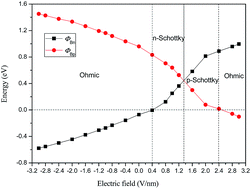Tuning the Schottky contacts at the graphene/WS2 interface by electric field
Abstract
Using the first-principle calculations, we study the electronic structures of graphene/WS2 van der Waals (vdW) heterostructures by applying an external electric field (Eext) perpendicular to the heterobilayers. It is demonstrated that the intrinsic electronic properties of graphene and WS2 are quite well preserved due to the weak vdW contact. We find that n-type Schottky contacts with a significantly small Schottky barrier are formed at the graphene/WS2 interface and p-type (hole) doping in graphene occurs during the formation of graphene/WS2 heterostructures. Moreover, the Eext is effective to tune the Schottky contacts, which can transform the n-type into p-type and ohmic contact. Meanwhile, p-type (hole) doping in graphene is enhanced under negative Eext and a large positive Eext is required to achieve n-type (electron) doping in graphene. The Eext can control not only the amount of charge transfer but also the direction of charge transfer at the graphene/WS2 interface. The present study would open a new avenue for application of ultrathin graphene/WS2 heterostructures in future nano- and optoelectronics.



 Please wait while we load your content...
Please wait while we load your content...